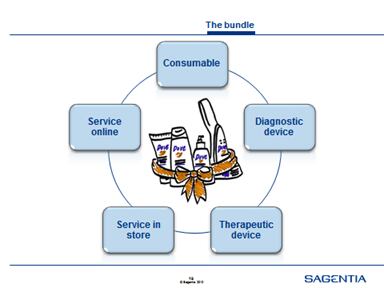Dan Edwards, senior vice president of Sagentia’s consumer & industrial products division, a company that specializes in the research and development of such devices, explains that the basic notion of a brand bundle is a consumable cosmetic product, an electronic device and a services, combined.
“This full bundle could be a therapeutic device or a diagnostic device, and a service might be a real world, available in a store, spa or salon, or else online," Edwards explained in an exclusive interview with Cosmetics Design.
The elements of the bundle are designed to reinforce one another, with a diagnostic advice function likely to provide personalization, whereas a therapeutic device might leverage a formulated cosmetic product.
“What this means to the consumer is a likely a more personalized and certainly deeper connection to the brand,” said Edwards.
Devices are earmarked for significant growth
Although cosmetics devices are already a fairly established category in North America, market research company Kline Group earlier this year predicted that the category is set for significant growth, and also earmarked the European market as the next geographic area to take up the trend.
Likewise, Mintel researcher Nica Lewis has also identified the concept of brand bundling, earmarking as being likely to provide greater functionality and personalization for the conumser, as well as providing brand owners with significant opportunities.
According to Edwards, the brand bundling builds on the devices concept by helping to bring about reinforcement with the consumer, due to the fact that having other touch points, the brand can build a geater mindshare and interactivity.

Unilever's DADI device is an example of brand bundling
One example of brand bundling is Unilever’s DADI device, which is a high-tech diagnostic designed around the Dove hair care range, that aims to support brand activation, engage consumer and encourage the use of the products, by determining the hair care requirements and suggesting specific products and how to use them.
Once the analysis has been made of the hair, the device connects to the internet and uploads the damage scores and physical data, providing an engaging tool for consumers to keep a track of their hair care requirements.
Edwards also points to the fact that consumers want devices to be more presonalized, to enhance both its efficacy and its intamacy, factors that brand bundling can address.
But likewise, it can also bring advantages to the brand itself, specifically by helping to create a specific business model that can be developed and molded around the consumer’s needs.
Significant advantages and flexibility to brand owners
“Unlike a device manufacturer who only sells devices we have the option to tradeoff margins on consumables revenue stream and margin on device sale. Thus we are not bound to a strict math formula to determine the retail price of a device as a function of its cost to manufacture,” said Edwards.
Although there are still not many examples of brand bundling on the market, Edwards believes that because big players such as Unilever and Procter & Gamble have already taken up on the concept, the trend is set for significant growth in the future.
Two further articles in this series that will be published shortly will look at other aspects of cosmetics devices, including technology migration and the integration of diagnostics into devices, in more detail.
